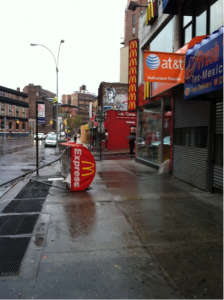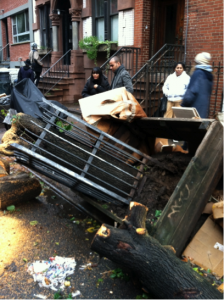Superstorm Sandy was a wake-up call for New Yorkers. Since the storm, terms like resiliency and sustainability have become pillars of both Mayor Bloomberg and de Blasio’s programs. For me, the storm transformed combatting climate change from an interest to a life’s mission. It brought the dangers to the steps of my apartment. I remember how the neighborhood I grew up and lived in, the Lower East Side, was plunged into darkness. I remember seeing a river flood down Avenue C that night and the destruction that was left the next morning.
 With Superstorm Sandy on my mind, last week I attended a community meeting about plans to prevent destruction from future storms. The initiative, called the East Side Coastal Resiliency project (ESCR), will be designed to mitigate future climate change and flood risks on Manhattan’s East Side. It is an example of how public-private partnerships that engage with community stakeholders can help develop more resilient and sustainable cities. The project is set to begin work in 2017 and finish by 2019. Between now and 2017 engineers will run feasibility tests for the proposed designs along the river, and the public and private partners will be holding a series of community engagement workshops to gauge community needs and preferences.
With Superstorm Sandy on my mind, last week I attended a community meeting about plans to prevent destruction from future storms. The initiative, called the East Side Coastal Resiliency project (ESCR), will be designed to mitigate future climate change and flood risks on Manhattan’s East Side. It is an example of how public-private partnerships that engage with community stakeholders can help develop more resilient and sustainable cities. The project is set to begin work in 2017 and finish by 2019. Between now and 2017 engineers will run feasibility tests for the proposed designs along the river, and the public and private partners will be holding a series of community engagement workshops to gauge community needs and preferences.
To fund the ESCR project New York City has received $335 million in federal funding from the Office of Housing and Urban Development (HUD). In June 2013, HUD and the city launched the Rebuild by Design competition to find the most innovative, practical and resilient design to protect the area from Montgomery Street to 23rd Street on Manhattan’s eastside. In June of 2014 Bjarke Ingels Group (BIG), an urban design firm, was selected as the winner of the Rebuild by Design competition. Following BIG’s selection, they were joined by a team of New York City public agencies, including the Departments of Design and Construction, Parks and Recreation and Office of Recovery and Resiliency, and private sector partners, including environmental engineers from AKRF, ARCADIS, CH2M Hill, Mathews Nielsen and urban design experts from Starr Whitehouse and One Architecture. The project already includes nine organizations and, according to one representative from AKRF, it will include well over a dozen by project completion.
At the meeting I attended the conversation was about the section of the East River Park between 14th and 23rd  Street. There were a number of proposals that fall under three categories: berm/levee; flood wall; or deployable walls. More specific ideas included a berm that could function as a very large, grassy bench or raised park along the river, a protective pavilion beneath the raised FDR Drive, a flip-down canopy of walls that double as benches, and a wiggle-wall across the street from the river. For each idea the speakers described the pros and cons based on cost, urban design and resiliency. After the ideas were presented, local attendees voted on their preferred proposals during smaller breakout sessions.
Street. There were a number of proposals that fall under three categories: berm/levee; flood wall; or deployable walls. More specific ideas included a berm that could function as a very large, grassy bench or raised park along the river, a protective pavilion beneath the raised FDR Drive, a flip-down canopy of walls that double as benches, and a wiggle-wall across the street from the river. For each idea the speakers described the pros and cons based on cost, urban design and resiliency. After the ideas were presented, local attendees voted on their preferred proposals during smaller breakout sessions.
It was exciting to see the number of name-tagged individuals at the workshop representing the various firms, all in the business of creating a more resilient city. Because these firms are working with the city, they are not just in the business of resiliency; they are also addressing local needs. As part of the RFP for the ESCR project, all firms are required to participate in the community engagement workshops. These workshops might slowdown the project’s launch, but they help avoid more costly delays from community disapproval once building is underway. Community members not only have the opportunity to voice their preferences among the proposed designs, but these meetings also provide a platform for sharing additional information. The urban planners and engineers were able to learn about preferred entrances to the park along the river, which sections are considered the most secluded and dangerous, and which overpasses and crosswalks across the FDR drive are the safest and most accessible. One of the design leads from BIG told me they want to do more than secure the area from the flooding; they want to use this as an opportunity to improve the area as well.
Although I am still worried about future hurricanes, I felt invigorated after the ESCR Project workshop for three reasons. First, New York City and the federal government are taking the threats from climate change seriously. We obviously need to emit less greenhouse gases—well below current levels. But, we also need to be realistic about the many risks we may be too late to prevent. Resiliency means both reducing emissions to more sustainable levels but also planning our towns, cities and infrastructure with sea level rise and severe storms in mind. Second, it was invigorating to see how the need for resiliency is creating opportunities for teams of businesses. Just like manufacturing weapons for World War II provided a boost to a depressed American economy, building the infrastructure to prevent costly damage from future storms can lead to economic development, opportunities for business and jobs. Third, taking on resiliency development via private-public partnerships with meaningful community engagement is ensuring that these developments are democratic. Resiliency efforts defeat their own purpose if their creation destroys valued community assets. Personally, I hope that this type of community engagement and public-private partnerships become more of the norm for all development, not just for preventing the next flood.